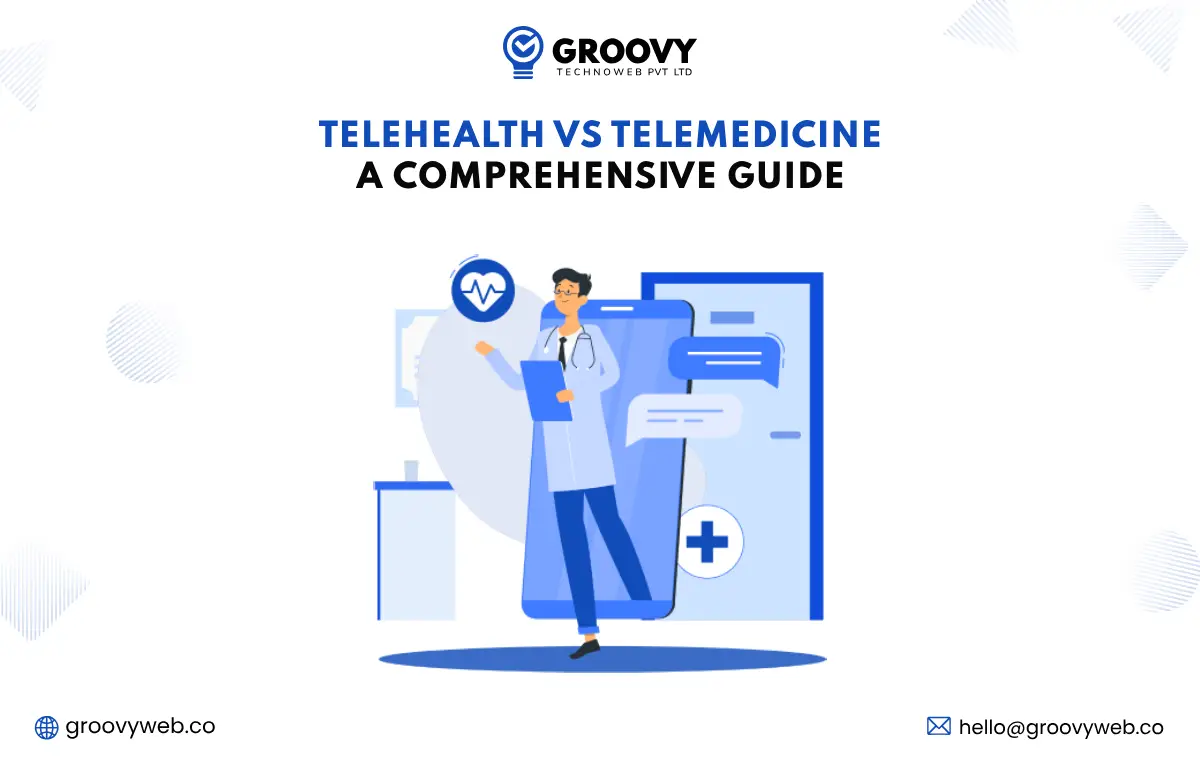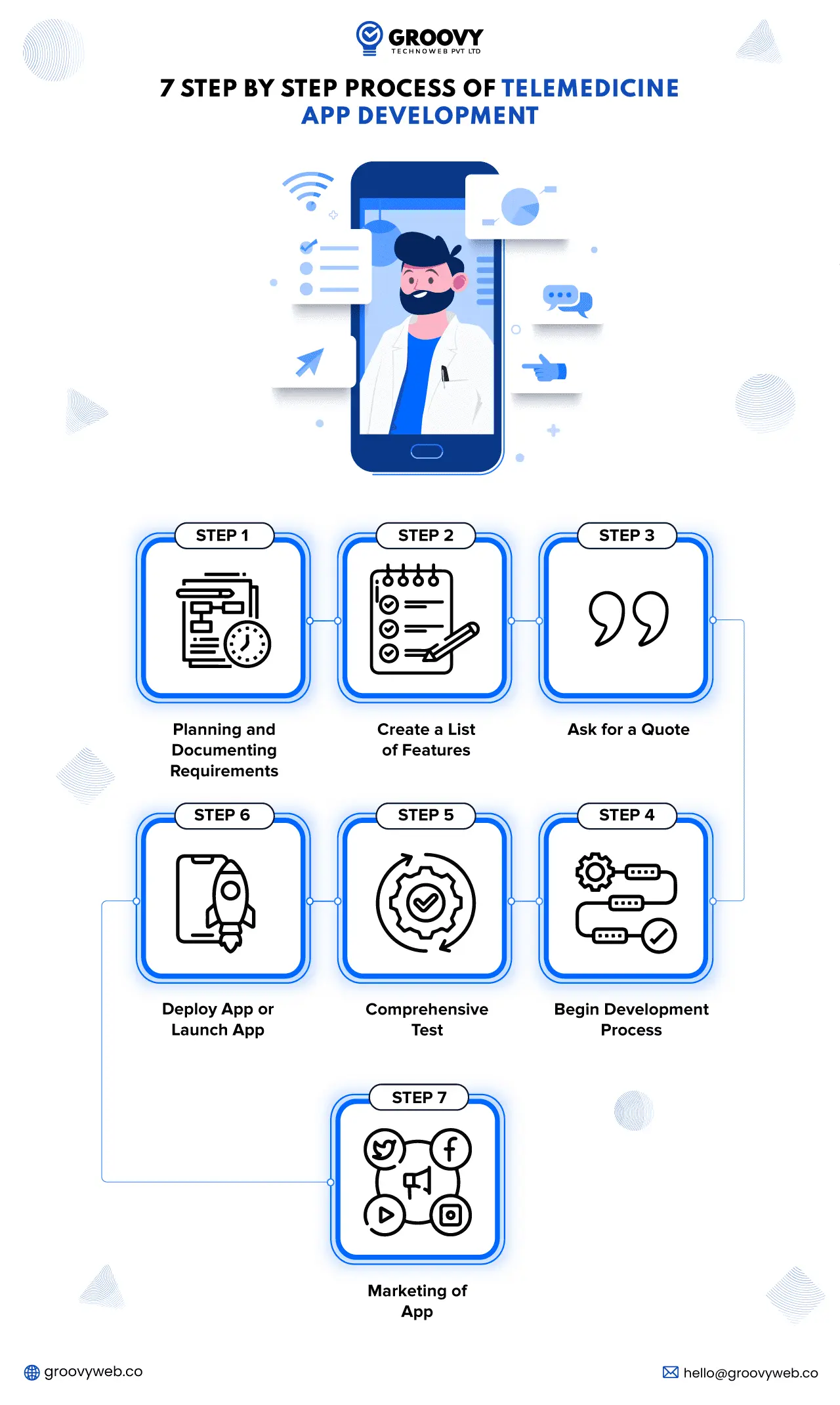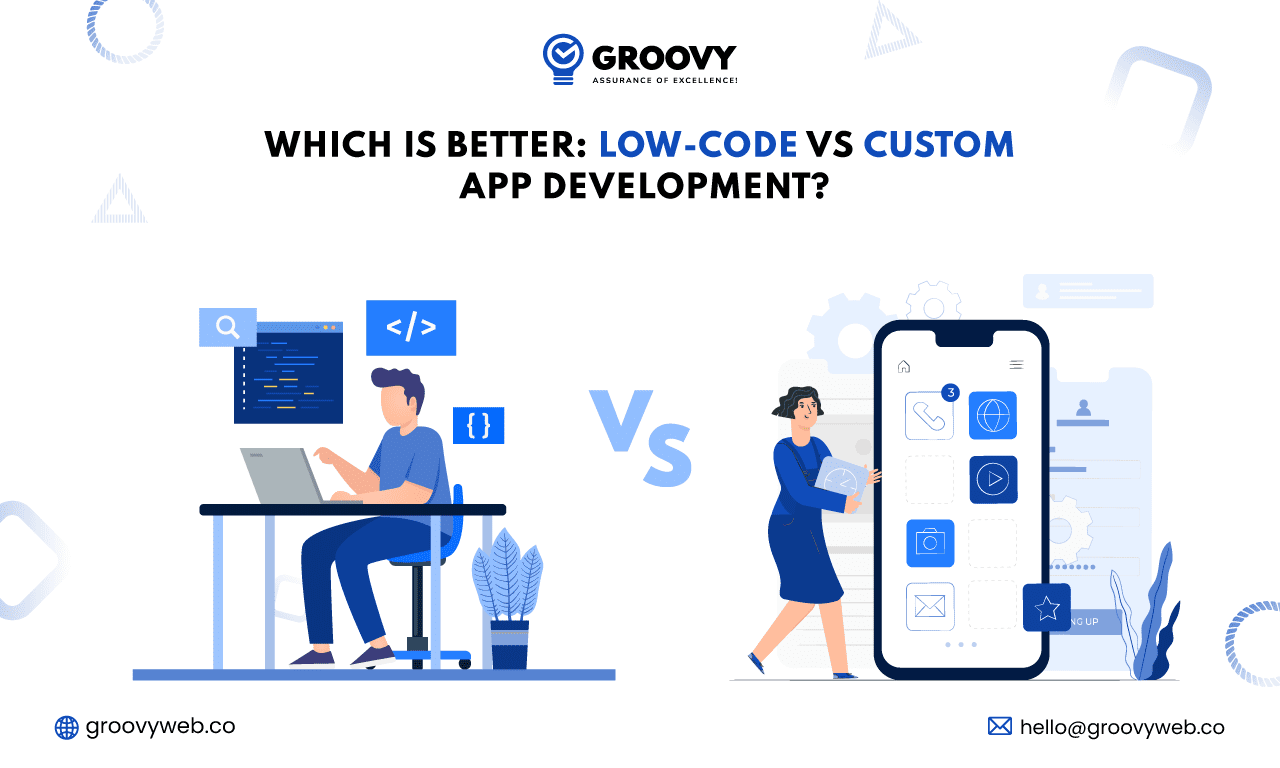Telehealth vs Telemedicine: A Comprehensive Guide
Sagar Patel
November 04, 2023 240 Views
Quick Summary : Explore the intricate differences between telehealth and telemedicine in this comprehensive guide. Delving into the unique features, applications, and advantages of these remote healthcare services, this guide provides a detailed roadmap for distinguishing between the two innovative approaches transforming the healthcare landscape.
In the rapidly advancing world of healthcare, the terms “telehealth” and “telemedicine” often intermingle, leading to confusion about their precise meanings and applications. Understanding the subtle yet distinct differences between these terms is pivotal for navigating the evolving landscape of remote healthcare. This comprehensive guide aims to delineate the disparities between telehealth and telemedicine, shedding light on their definitions, unique features, applications, and the benefits they offer.
Understand Telehealth vs. Telemedicine
In modern healthcare, the terms “telehealth” and “telemedicine” are commonly used but can be misconstrued. Let’s demystify these terms to kick off our comprehensive guide.
Telehealth serves as the encompassing umbrella term, involving a range of health services delivered remotely. This spans beyond clinical services to encompass non-clinical activities, including patient education, administrative meetings, and remote monitoring of vital signs. Leveraging technology, telehealth facilitates doctor appointments via apps, offering patients a convenient means to access healthcare services from a distance.
On the other hand, telemedicine operates as a subset of telehealth, specifically emphasizing the utilization of technology to provide clinical services and medical consultations remotely.
Telehealth
Telehealth is a broad umbrella term that includes a wide range of health services delivered remotely. It comprises not only clinical services but also non-clinical activities such as remote monitoring of vital signs, patient education, and administrative meetings. Telehealth extends beyond the traditional clinical environment to encompass various health-related services accessible from a distance.
Telemedicine
Telemedicine, on the other hand, is a subset of telehealth. It specifically refers to the use of technology for providing clinical services and medical consultations remotely. This can include virtual doctor-patient consultations, remote diagnosis, and treatment using telecommunications technology.
Distinguishing Features
Scope of Services: Telehealth encompasses a broader spectrum of healthcare services, incorporating clinical and non-clinical activities. Telemedicine, however, is more specific and pertains solely to clinical services and medical consultations conducted remotely.
Applications: Telehealth’s applications span various healthcare services, including remote monitoring, education, administrative meetings, and more. Telemedicine predominantly focuses on remote clinical care, consultations, and diagnosis.
Technological Tools: While both telehealth and telemedicine heavily rely on technology, the tools and applications used can vary. Telehealth might involve a broader range of technology, including wearables, mobile apps, and communication systems. Telemedicine often involves video conferencing, remote diagnostic tools, and electronic health records for clinical consultations.
Benefits of Telemedicine
Increased Access to Healthcare: Telemedicine facilitates access to medical consultations and care remotely, especially for individuals in remote areas or those with limited mobility. It enables them to receive medical advice without needing in-person visits.
Convenience and Time-Saving: Patients can schedule virtual appointments at their convenience, saving travel time and reducing waiting room periods, making healthcare more efficient and accessible.
Continuity of Care: For individuals with chronic conditions, telemedicine allows continuous monitoring and follow-up consultations with healthcare providers, ensuring consistent care without frequent physical visits.
Lower Costs: Telemedicine often reduces healthcare app development costs for both patients and providers. It minimizes expenses related to transportation and office visits and sometimes even offers lower consultation fees.
Faster Medical Advice: Immediate access to medical advice in urgent situations without waiting for a physical appointment, contributing to more rapid diagnosis and treatment.
Remote Monitoring: It allows for remote monitoring of health conditions through wearable devices and innovative technology, providing real-time data to healthcare providers for proactive care management.
Benefits of Telehealth Apps
Comprehensive Healthcare Services: Telehealth apps offer a wide range of services, including not just clinical care but also patient education, administrative meetings, mental health support, and chronic disease management.
Accessibility and Flexibility: Users can access healthcare services from anywhere, at any time, enhancing convenience and flexibility. This accessibility is beneficial for those with busy schedules or limited mobility.
Health Education and Promotion: Telehealth apps often provide educational resources and tools to promote healthier lifestyles, enabling users to access information about wellness, preventive care, and self-management of health conditions.
Remote Prescription Refills: Some telehealth apps offer features to request prescription refills and consultations for ongoing medication, reducing the need for in-person visits for routine prescription updates.
Reduced Hospital Readmissions: By offering post-discharge follow-up consultations and continuous monitoring, telehealth apps contribute to reducing hospital readmissions and enhancing patient recovery and healthcare outcomes.
Data & Analytics: These apps often incorporate features for users to track health data, facilitating self-assessment and allowing healthcare providers to analyze trends for better treatment planning and management.
Delineating the Scope of Services
Telehealth’s expansive scope encompasses various healthcare services, including clinical and non-clinical activities. This involves not just remote consultations but also educational sessions, administrative meetings, and remote monitoring, catering to various aspects of healthcare. Telemedicine, however, is more singularly focused on remote clinical care, consultations, diagnosis, and treatment using telecommunication technology.
Different Technological Tools in Telehealth vs. Telemedicine
Both telehealth and telemedicine rely heavily on technology. However, the tools and applications used often differ between the two.
Telehealth encompasses various technological tools, including wearables, mobile applications, and multiple communication systems.
In contrast, telemedicine predominantly relies on video conferencing, remote diagnostic tools, and electronic health records for clinical consultations and patient care.
Differences between telehealth vs telemedicine app
| Aspect | Telemedicine | Telehealth |
| Scope | Focuses on remote clinical care and services | Offers a broader range beyond clinical care |
| Services | Primarily, clinical consultations and diagnosis | Include patient education, administrative meetings, mental health support, chronic disease management, etc. |
| Use Case | Primarily for medical consultations and urgent care | Offers comprehensive healthcare services, education, and ongoing care management |
| Technological Tools | Primarily involves video conferencing, remote diagnostic tools | Uses a wide range of technology for diverse health-related activities |
| Accessibility | Provides remote access to medical advice and care | Allows access to healthcare services from anywhere, promoting flexibility |
| Data & Analysis | Focuses on remote diagnosis and monitoring | Includes data tracking for self-assessment and improved treatment planning |
| Examples | Virtual doctor-patient consultations, remote diagnosis | Health education resources, mental health support, chronic disease management, administrative meetings |
How Applications of Telehealth & Telemedicine Can be Benefitable?
The applications and benefits of both telehealth and telemedicine are manifold. They include:
- Enhanced accessibility to healthcare services, particularly for remote or underserved populations.
- Cost-effectiveness by reducing the need for physical infrastructure and frequent in-person appointments.
- Patient empowerment through remote monitoring, education, and engagement.
- Streamlined healthcare delivery, leading to increased efficiency and effective care.
How to Develop Telemedicine & Telehealth App
Developing a telemedicine or telehealth app involves various stages, from planning to execution. Here’s an overview of the development process and some critical features for both types of apps:
Telemedicine App Development:
Planning and Research: Identify the target audience, define the app’s purpose, and research legal and regulatory requirements for medical services.
Choose Technology Stack: Select the appropriate tech stack based on the app’s requirements, ensuring compliance with security standards and HIPAA regulations.
Features of Telemedicine App:
- User Authentication: Secure login for patients and healthcare professionals.
- Scheduling and Calendar Integration: Appointment scheduling and calendar sync.
- Real-time Video Consultations: High-quality video conferencing for remote consultations.
- Secure Messaging: Secure chat or messaging for communication between doctors and patients.
- EMR/EHR Integration: Electronic Medical Records (EMR) or Electronic Health Records (EHR) integration for medical history access.
- Prescription Services: Ability to issue electronic prescriptions.
- Payment Gateway: Secure payment processing for consultation fees.
- Multilingual Support: Support for multiple languages for broader accessibility.
Telehealth App Development
Identify the Purpose: Determine the primary goal of the app – whether it’s patient education, monitoring, or a comprehensive healthcare platform.
Technology Stack: Choose suitable technology and ensure compliance with data protection laws.
Features of Telehealth App:
- Health Education Resources: Information on various health topics and conditions.
- Remote Monitoring Tools: Integrating wearables and sensors for health data tracking.
- Mental Health Support: Access to mental health professionals or resources.
- Chronic Disease Management: Tools for managing long-term conditions and medications.
- Wellness Programs: Features promoting fitness, nutrition, and overall well-being.
- Community Forums: Engaging users through discussion forums or support groups.
- Notification and Alerts: Reminders for medication, appointments, or health-related activities.
- Data Analytics: Features for users to track and analyze health data.
Both telemedicine and telehealth apps can offer remote access to healthcare services but with differing objectives and functionalities. The development process involves careful planning, understanding user needs, and compliance with healthcare regulations to ensure a secure and effective platform for users and healthcare providers.
How much does it cost to develop a telemedicine mobile application?
The cost of developing a telemedicine app can vary significantly based on multiple factors such as features, complexity, platform, development team location, and more. It’s essential to consider the following aspects that can influence the overall cost:
- App Features: The more complex the features, the higher the development cost. Basic functionalities like video consultations, scheduling, and secure messaging are standard. Advanced features such as EHR integration, remote monitoring, or AI-driven diagnostics will add to the cost.
- Platform: Whether it’s for iOS, Android, or both will impact the cost. Native apps often cost more than cross-platform or hybrid apps due to different development requirements.
- Design and User Experience: High-quality design and user-friendly interfaces are crucial and might contribute to the cost.
- Compliance and Security: Telemedicine apps must comply with healthcare regulations like HIPAA, ensuring patient data security. Compliance measures add to development costs.
- Development Team Location: Costs vary based on the region. Development teams in different countries charge differently.
On average, the cost to develop a basic telemedicine app can start from $30,000 to $50,000. However, for a more comprehensive app with a wide range of features and high-end functionalities, the cost can escalate to $100,000 and beyond. The final cost could be even higher for complex systems with custom features and extensive integrations.
It’s crucial to collaborate with a professional telemedicine app development team, discuss your specific requirements, and get a detailed estimate based on the functionalities you need in your app. This will help in getting a more accurate idea of the costs involved in your particular case.
Conclusion
In conclusion, differentiating between telehealth and telemedicine is crucial in understanding the breadth of remote healthcare. Telehealth covers a more extensive range of services, while telemedicine focuses primarily on remote clinical care. Both are vital in revolutionising healthcare delivery, offering innovative and accessible solutions to patients and healthcare providers.
We hope this guide clarifies the differences between telehealth and telemedicine. Your thoughts and experiences on these remote healthcare services are valuable. Please share your insights in the comments below.
Bonus Infographic:- How to Create Telemedicine App?

Written by: Sagar Patel
Sagar Patel is the CTO and Co-founder of Groovy Web. He was involved in the telecommunications & Automation industry during his early career. Still, due to his attitude toward learning anything new and mastering it, he now works as a CTO for Groovy Web. Through their business mindset and logical approach, they have taken their company to the next level; His responsibilities now include all aspects of the business. Among them are finance, process design, and development.
Frequently Asked Questions
We hope these clear your doubts, but if you still have any questions, then feel free to write us on hello@groovyweb.coWhat types of healthcare services can be provided through telehealth?
Telehealth encompasses a wide range of services, including but not limited to primary care consultations, mental health counselling, follow-up appointments, prescription management, and monitoring of chronic conditions.
What technology do I need to access telehealth services?
To access telehealth services, you generally need a device with internet access, such as a computer, smartphone, or tablet. You may also need to download specific apps or software provided by the healthcare provider.
Are there any privacy concerns with telehealth?
Telehealth platforms are designed to be secure and comply with healthcare privacy regulations (such as HIPAA in the United States). It's important to choose reputable and secure platforms and to follow best practices for protecting your personal health information.
Related Blog

Rahul Motwani
Which is Better: Low-Code vs Custom App Development?
Mobile App Development 12 Jun 2023 14 min read
Rahul Motwani
Progressive Web Apps Development Guide: Benefits, Cost, Characteristics & Examples
Web App Development 06 Feb 2023 15 min read
Nauman Pathan
PWA for eCommerce: How are PWA Useful to eCommerce Platforms?
Web App Development 06 Feb 2023 19 min readSign up for the free Newsletter
For exclusive strategies not found on the blog